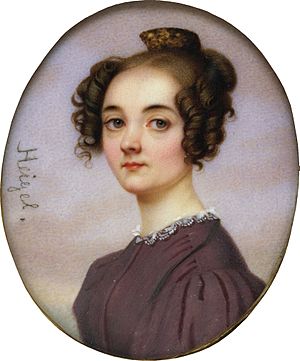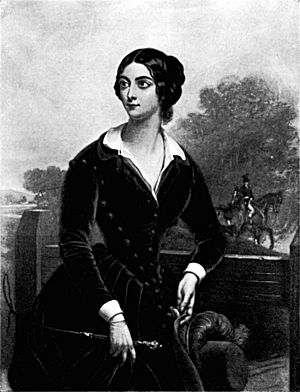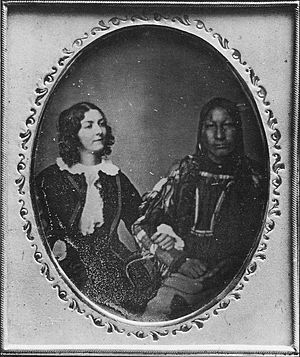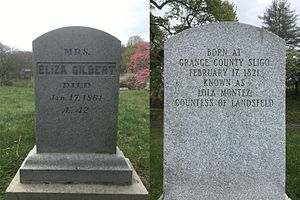Lola Montez facts for kids
Quick facts for kids
Lola Montez, Gräfin von Landsfeld
|
|
|---|---|
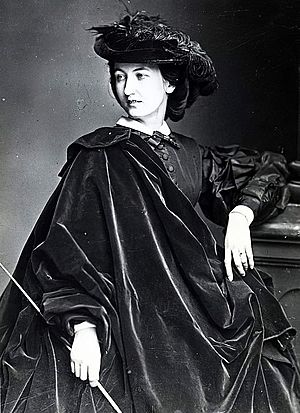
Lola Montez photographed by Antoine Samuel Adam-Salomon, 1860
|
|
| Born |
Eliza Rosanna Gilbert
17 February 1821 Grange, County Sligo, Connacht, Ireland
|
| Died | 17 January 1861 (aged 39) |
| Nationality | Irish |
| Other names | Donna Lola Montez, Maria Dolores Eliza Rosanna Gilbert, Countess of Landsfeld |
| Occupation | Dancer, actress, lecturer, author |
| Spouse(s) |
Lieutenant Thomas James
(m. 1837; div. 1842)George Trafford Heald
(m. 1849; div. 1850)Patrick Hull
(m. 1853; div. 1853) |
| Partner(s) | King Ludwig I of Bavaria (1846–1848) |
Lola Montez (born Eliza Rosanna Gilbert) was an amazing Irish dancer and actress. She became very famous for her exciting "Spanish dancer" performances. Lola was also a special friend and advisor to King Ludwig I of Bavaria.
The King was so impressed by her that he gave her the important title of Countess of Landsfeld. However, when big changes and revolutions started in 1848, Lola had to leave. She traveled through many countries before going to the United States. There, she continued her career as an entertainer and lecturer.
Contents
Biography
Early Life and Adventures
Eliza Rosanna Gilbert was born on February 17, 1821, in Grange, Ireland. Her family was Anglo-Irish. Her parents, Edward Gilbert and Eliza Oliver, married in 1820.
For many years, people thought she was born in Limerick. But later, her baptism certificate showed her true birthplace and date. She was baptized in Liverpool, England, in 1823. This happened while her family was on their way to India.
Life in India and Schooling
Soon after arriving in India, Eliza's father, Edward, sadly died. Her mother remarried Lieutenant Patrick Craigie. Patrick cared for young Eliza, but he worried about her wild behavior.
It was decided that Eliza should go back to Britain for school. She stayed with her stepfather's father in Scotland. Eliza was known for being a bit of a troublemaker. Once, she even put flowers in an old man's wig during church!
At age ten, Eliza moved to Sunderland, England, for more schooling. Her determination and strong will became her well-known traits. After a year, she moved again to a school in Bath for a more advanced education.
In 1837, when she was sixteen, Eliza ran away and married Lieutenant Thomas James. They separated five years later in India. After this, she decided to become a professional dancer. She chose the stage name "Lola Montez."
Becoming a Dancer
Lola made her first public appearance as "Lola Montez, the Spanish dancer" in London in June 1843. People soon recognized her as "Mrs. James." This made it hard for her career in England.
So, she moved to Europe, where she found success. She performed in big cities like Paris and Warsaw. Her unique dancing style and strong personality made her famous.
Countess of Landsfeld
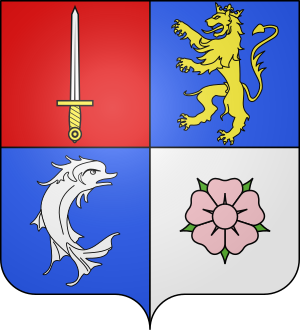
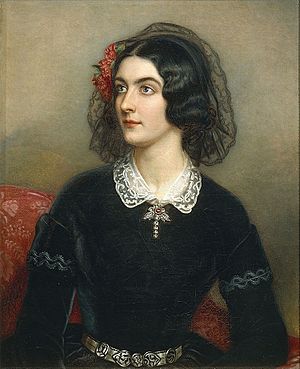
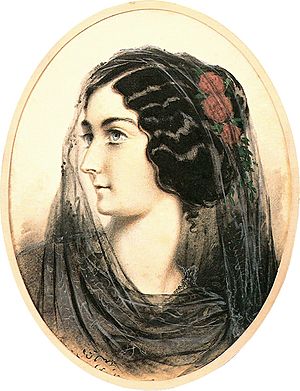
In 1846, Lola arrived in Munich, Germany. There, she met King Ludwig I of Bavaria. She quickly became a very important person in his life. The King was very fond of her.
On his birthday, August 25, 1847, King Ludwig gave Lola the title of Countess of Landsfeld. He also gave her a lot of money each year. This showed how much influence she had.
Political Influence
For over a year, Lola had a lot of political power. She used her influence to support new ideas and challenge old ways. She also spoke out against certain groups, like the Jesuits.
Lola's ability to influence the King was so strong that his main minister, Karl von Abel, was fired. This happened because the minister and his team did not want Lola to become a Bavarian citizen or a Countess.
Students at Munich University had different opinions about Lola. This led to arguments just before the revolutions of 1848 began. Because of Lola's insistence, the King even closed the university for a short time.
End of Her Influence
In March 1848, a big revolutionary movement grew stronger. The university was reopened. King Ludwig gave up his throne to his son, King Maximilian II. Lola Montez had to leave Bavaria.
Her time as a powerful figure behind the King was over. Many people believe that King Ludwig's close relationship with Lola was a big reason why he had to step down, even though he was popular before.
After leaving Bavaria, Lola stayed in Switzerland for a while. She hoped King Ludwig would join her, but he never did. She then made a quick trip to France before moving to London in late 1848. In 1851, she decided to start fresh in the United States.
American Career
From 1851 to 1853, Lola performed as a dancer and actress in the eastern United States. One of her popular shows was called Lola Montez in Bavaria. In May 1853, she arrived in San Francisco, California. Her performances there caused a huge stir!
In July, she married Patrick Hull, a local newspaper writer. They moved to Grass Valley, California, in August. However, her marriage did not last long.
Lola stayed in her small house in Grass Valley for almost two years. Her restored home is now a California Historical Landmark. Lola also inspired a young girl named Lotta Crabtree. Lotta's parents ran a boarding house nearby. Lola, as a neighbor, gave Lotta dancing lessons and encouraged her love for performing.
Later Life and Legacy
Lola tried to make a comeback in theater in different American cities, but it didn't work out. In 1857, she arranged to give a series of lectures about good morals in Britain and America. These talks were written by a minister named Rev. Charles Chauncey Burr.
Lola spent her final days helping women in need.
Burial
Lola Montez passed away at the age of 39 on January 17, 1861. She is buried in Green-Wood Cemetery in Brooklyn, New York. Her tombstone says: "Mrs. Eliza Gilbert | Died 17 January 1861 | Æ. 42". The "Æ." means "at the age of."
Images for kids
-
Lola Montez in 1851, daguerreotype by Southworth & Hawes
See also
 In Spanish: Lola Montez para niños
In Spanish: Lola Montez para niños


